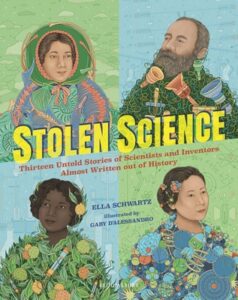Stolen Science
Ella Schwartz
Illustrated by Gaby D’Alessandro
Bloomsbury
Published August 31, 2021
Amazon | Bookshop | Goodreads
About Stolen Science
Over the centuries, women, people from underrepresented communities, and immigrants overcame prejudices and social obstacles to make remarkable discoveries in science-but they weren’t the ones to receive credit in history books. People with more power, money, and prestige were remembered as the inventor of the telephone, the scientists who decoded the structure of DNA, and the doctor who discovered the cause of yellow fever.
This book aims to set the record straight and celebrate the nearly forgotten inventors and scientists who shaped our world today.
My Review
I devoured this book. Seriously, I couldn’t get enough of these stories of men and woman who did these incredible things. Some of them knew that they could not (under current racist or sexist systems) receive credit for what they’d done. Others never stopped fighting for the recognition they deserved. I loved getting this opportunity to learn some of the real history of different scientific advancements, some of which I’d heard of or learned about in school, and learning that there was so much more to the story, and often someone I’d never heard of behind it all.
You don’t have to go back very far in my family to find my Italian relatives who emigrated to the US, so the story of Antonio Meucci, the true inventor of the telephone really struck a deep chord with me. I found myself online reading articles and looking for more information about him.
The beginning of the book points out how there are few women scientists that most people can name off the top of their heads. You know, besides Marie Curie. I loved reading about these women who overcame steep prejudices to even get access to the field of science. While it was awful thinking about these people who were taken advantage of by their colleagues or a deliberately racist and/or sexist system, it was also inspiring to read about people who had such a passion for their work.
Some of the stories in STOLEN SCIENCE are about inventors who, because they were slaves, could not legally apply for or be listen on a patent, and therefore couldn’t be given credit for their work. This shouldn’t have surprised me, given what I know about that period in history. I wasn’t surprised exactly. I guess it just reinforced the gross wrong that slavery and racism was and is.
Reading STOLEN SCIENCE made me want to find other books like this. I want to read more books that celebrate little-known or overlooked scientists or inventors and to learn more about them. If you like nonfiction that explores the less well-known contributions that people have made to our world, check out this list celebrating Women’s History on Bookshop. You might also be interested in THE BOY FROM BUCHENWALD by Robbie Waisman or GIRL WARRIORS by Rachel Sarah.
Content Notes
Recommended for Ages 10 to 14.
Representation
Features biographies of white, Black, Jewish, and Chinese inventors.
Profanity/Crude Language Content
None.
Romance/Sexual Content
Brief mention of men insulting a woman’s appearance.
Spiritual Content
None.
Violent Content
Mentions of slavery, Nazi rule, and internment camps.
Drug Content
None.
Note: This post contains affiliate links, which do not cost you anything to use, but which help support running this blog. I received a free copy of STOLEN SCIENCE in exchange for my honest review.
